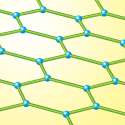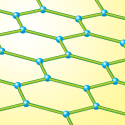Triple decker
Graphene, a remarkably robust conducting material made up of a single layer of carbon atoms, is poised to establish a new paradigm in electronic devices. Already, graphene has been used to make a transistor that is not much larger than a molecule.
Currently, intense experimental research is focused on understanding how the number of layers in a graphene device affect its electronic properties. In an article appearing in Physical Review B, Mikito Koshino at the Tokyo Institute of Technology and Edward McCann at Lancaster University propose a device made up of three stacked sheets of graphene subject to external gate potentials, and they show that its behavior is qualitatively different from that exhibited by single- and bilayer graphene.
Using a self-consistent scheme, they calculate the electronic band structure in the presence of a gate potential and disorder. When an electric field is applied perpendicular to the layers, it breaks mirror reflection symmetry with respect to the central layer. This leads to a hybridization of the low-energy electron bands, resulting in two of these bands shifting close to the Fermi level. The authors find that conductivity should increase with an increasing gate field, which is in sharp contrast to the situation found in bilayer graphene where a gate field actually suppresses conductivity. – Alex Klironomos





